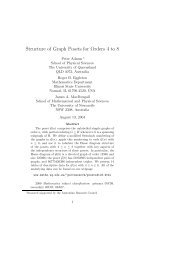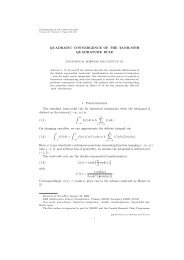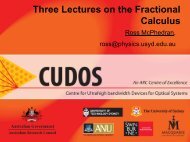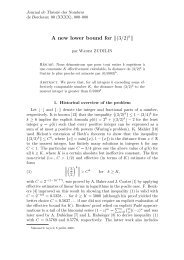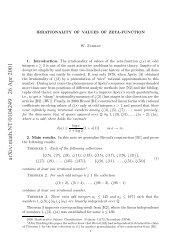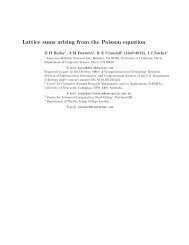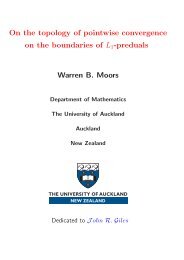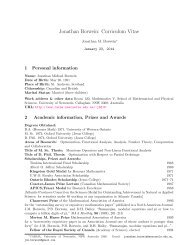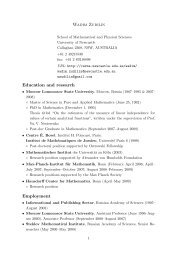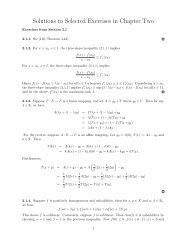The Laplace transform of the psi function - DocServer
The Laplace transform of the psi function - DocServer
The Laplace transform of the psi function - DocServer
Create successful ePaper yourself
Turn your PDF publications into a flip-book with our unique Google optimized e-Paper software.
ON THE LAPLACE TRANSFORM OF THE PSI FUNCTION<br />
M. LAWRENCE GLASSER AND DANTE MANNA<br />
Abstract. Guided by numerical experimentation, we have been able to prove that<br />
Z<br />
8 π/2 x 2<br />
π 0 x 2 + ln 2 dx = 1 − γ + ln(2π)<br />
[2cos(x)]<br />
and to establish a connection with <strong>the</strong> <strong>Laplace</strong> <strong>transform</strong> <strong>of</strong> ψ(t + 1).<br />
(1)<br />
1. Introduction<br />
Interest in this project began with curiosity about <strong>the</strong> <strong>Laplace</strong> <strong>transform</strong> <strong>of</strong> <strong>the</strong> Digamma <strong>function</strong>,<br />
L(a) :=<br />
∫ ∞<br />
0<br />
e −as ψ(s + 1)ds ,<br />
which is conspicuously absent from <strong>the</strong> extensive literature and tabulations <strong>of</strong> Euler’s Gamma <strong>function</strong>.<br />
As will be seen, this can be related to <strong>the</strong> odd logarithmic integral<br />
(2)<br />
M(a) :=<br />
4 π<br />
∫ π/2<br />
0<br />
x 2<br />
x 2 + ln 2 (2e −a cos(x)) dx .<br />
If one plots L(a) + γ/a and M(a) <strong>the</strong> graphs coincide for a ≥ ln(2), that for M(a) exhibits a cusp<br />
at a = ln(2) and decreases to <strong>the</strong> finite value M(0) = 1.13033... , whereas L(0) is divergent (Fig. 1).<br />
<strong>The</strong> first author was quite surprised to receive an e-mail from Olivier Oloa <strong>of</strong> <strong>the</strong> University <strong>of</strong><br />
Versailles asking about a number <strong>of</strong> integrals equivalent in form to (2) and a second note somewhat<br />
later stating that<br />
M(0) = 4 π<br />
∫ π/2<br />
0<br />
x 2<br />
x 2 + ln 2 dx = (1 − γ + ln(2π))/2 .<br />
(2 cos(x))<br />
(3)<br />
4<br />
7<br />
6<br />
5<br />
3<br />
2<br />
1<br />
0<br />
0.0<br />
0.4 0.8 1.2 1.6 2.0 2.4 2.8 3.2 3.6<br />
4.0<br />
Figure 1. graph <strong>of</strong> L(a) + γ/a (upper) versus M(a)<br />
1
2 M. LAWRENCE GLASSER AND DANTE MANNA<br />
Indeed this value had been guessed by making <strong>the</strong> reasonable assumption based on <strong>the</strong> connection<br />
with <strong>the</strong> Gamma <strong>function</strong> that <strong>the</strong> only transcendental numbers involved were Euler’s constant,<br />
ln(2) and ln(π). By examining <strong>the</strong> expression E(a, b, c, d) = a + bγ + c ln(2) + d ln(π) systematically<br />
for small rational values <strong>of</strong> <strong>the</strong> coefficients precisely <strong>the</strong> above value was obtained. At <strong>the</strong> time our<br />
note is written, this identity also appears in [8].<br />
<strong>The</strong> aim <strong>of</strong> this note is to provide <strong>the</strong> details <strong>of</strong> <strong>the</strong> relation between L(a) and M(a) and to derive<br />
<strong>the</strong> value <strong>of</strong> M(0). We present two pro<strong>of</strong>s <strong>of</strong> <strong>the</strong> evaluation M(0), as well as a sum formula for <strong>the</strong><br />
integral. <strong>The</strong> general form <strong>of</strong> (1) for real parameter a appears to be<br />
L(a) = M(a) − γ a − ln(ea − 1)<br />
H(ln 2 − a) ,<br />
1 − e−a where H denotes <strong>the</strong> unit step <strong>function</strong>. Oloa [7] has derived a conjecture for <strong>the</strong> general evaluation<br />
<strong>of</strong> <strong>the</strong> related integral M(a) for all real a > 0 which has been confirmed by numerical experiments.<br />
<strong>The</strong> derivation we present for <strong>the</strong> identity (3) in Section 2 begins by equating <strong>the</strong> integral in (2)<br />
with <strong>the</strong> form<br />
M(a) = πe −a ∫ 1<br />
0<br />
te −at<br />
Γ(1 − t)<br />
∑<br />
k−l≠1<br />
Γ(l − t)Γ(l − k − 1)<br />
(1 − e a ) k dt .<br />
l!Γ(l − k)<br />
When a = 0, <strong>the</strong> hypergeometric sum reduces to a 3 F 2 , and we conclude <strong>the</strong> evaluation by appealing<br />
to known evaluations <strong>of</strong> <strong>the</strong> ψ <strong>function</strong>.<br />
In Section 3, we start by simplifying <strong>the</strong> integrand via a partial fractions decomposition and<br />
change <strong>of</strong> variables. This results in a much simpler-looking integrand:<br />
∫ π<br />
y 2 dy<br />
0 y 2 + 4 ln 2 (2 cos( y 2 )) = i ∫ π<br />
(4) y dy<br />
4 −π log(e iy + 1) .<br />
<strong>The</strong> <strong>transform</strong>ation e iy ↦→ z in <strong>the</strong> right hand integral would be <strong>the</strong> next logical step, because it<br />
<strong>transform</strong>s <strong>the</strong> interval (−π, π) to a simple, closed contour in C that encircles <strong>the</strong> origin. However,<br />
doing so from (4) would introduce complex logarithms in <strong>the</strong> integrand. To compensate for this,<br />
we replace <strong>the</strong> integrand with an analytic integral and reverse order <strong>of</strong> integration. <strong>The</strong> result is to<br />
reduce (3) to <strong>the</strong> evaluations<br />
∫ 1<br />
0<br />
ln Γ(t) dt = ln( √ 2π) and (ln Γ) ′ (2) ≡ ψ(2) = 1 − γ .<br />
Definite integrals on [0, 1] involving ln(Γ(x)) such as this have appeared in earlier research <strong>of</strong> Espinosa<br />
and Moll; see [2], [4], [5] for details. We refer <strong>the</strong> reader to [9] for <strong>the</strong> analysis background concerning<br />
our steps <strong>of</strong> simplification that involve, for example, passing a sum through an integral or analytic<br />
continuation.<br />
From (4) we can also make a series expansion <strong>of</strong> <strong>the</strong> integrand and integrate termwise, yielding<br />
<strong>the</strong> formula<br />
∫ (<br />
)<br />
π<br />
y 2 dy<br />
0 y 2 + 4 log 2 (2 cos( y 2 )) = π ∞∑ (−1) m m+1<br />
∑ S 1 (m + 1, s)<br />
(5)<br />
1 +<br />
.<br />
2 m(m + 1)! s + 1<br />
m=1<br />
s=0<br />
<strong>The</strong> S 1 (m, s) are signed Stirling numbers <strong>of</strong> <strong>the</strong> first kind, which appear when one writes a power<br />
series expansion for 1/ log(1 + x) . We thus have, in view <strong>of</strong> (3), a new series evaluation.
ON THE LAPLACE TRANSFORM OF THE PSI FUNCTION 3<br />
2. Derivation <strong>of</strong> <strong>the</strong> Logarithmic Integral<br />
We begin by proving that <strong>the</strong> integrals L(a) + γ/a and M(a) agree for a > ln(2) . <strong>The</strong> former<br />
diverges for all o<strong>the</strong>r real values <strong>of</strong> a , so that <strong>the</strong> latter is seen as its analytic continuation. To start,<br />
formula (1.6.27) in [3] reads<br />
Hence<br />
(6)<br />
B(y) =<br />
= π 4<br />
∫ π/2<br />
0<br />
cos(xy)cos s (x)dx = 2 −s−1 Γ(s + 1)<br />
π<br />
Γ(1 + 1 2 s + 1 2 y)Γ(1 + 1 2 s − 1 2 y) .<br />
∫ π/2<br />
0<br />
2 −s Γ(s + 1)<br />
[<br />
Γ(1 + 1 2 s + 1 2 y)Γ(1 + 1 2 s − 1 2 y) ψ<br />
xsin(xy)cos s (x)dx = −B ′ (y)<br />
(<br />
1 + s 2 + y ) (<br />
− ψ 1 + s 2 2 − y )]<br />
2<br />
This generalizes Entry 33(i) in [1]. <strong>The</strong>refore, evaluating at y = s , we obtain <strong>the</strong> integral representation<br />
ψ(s + 1) = 2s+2<br />
π<br />
∫ π/2<br />
0<br />
xsin(sx)cos s (x)dx − γ .<br />
Substituting this into <strong>the</strong> previous expression, we obtain <strong>the</strong> double integral<br />
(7)<br />
L(a) + γ a = 4 π<br />
∫ ∞<br />
Writing sin(sx) = − Im(e −isx ) , this becomes<br />
Now <strong>the</strong> integral<br />
L(a) + γ a = − 4 π Im ∫ ∞<br />
∫ ∞<br />
0<br />
0<br />
∫ π/2<br />
e −(a−ln 2)s xsin(sx)cos s (x) dx ds.<br />
0<br />
∫ π/2<br />
0<br />
0<br />
xe s(ln[2e−a cos(x)]−ix) dx ds.<br />
e s(ln[2e−a cos(x)]−ix) ds for 0 < x < π/2<br />
is equal to 1/(ix − ln[2e −a cos(x)]) when a > ln 2 and does not converge for any o<strong>the</strong>r values <strong>of</strong> a .<br />
Thus, with this restriction in place, we may reverse <strong>the</strong> order <strong>of</strong> integration, yielding<br />
L(a) + γ a = − 4 π Im ∫ π/2<br />
0<br />
x<br />
ix − ln[2e −a cos(x)]<br />
dx = M(a) .<br />
<strong>The</strong>n, for 0 < a ≤ ln 2, we have M(a) as an alternative branch value <strong>of</strong> <strong>the</strong> <strong>function</strong> L(a) + γ/a.<br />
Now we retrace <strong>the</strong> our steps slightly differently, starting from (7). For fixed s > 0 , <strong>the</strong> imaginary<br />
part <strong>of</strong> integrand with respect to x is even; we write<br />
M(a) = 2 π Im ∫ ∞<br />
0<br />
∫ π/2<br />
−π/2<br />
xe s ln[2e−a cos(x)] e isx dx ds .<br />
<strong>The</strong>n using <strong>the</strong> <strong>function</strong>al equation e isx e sln[2e−a cos x] = e sln[e−a (1+e 2ix )] and <strong>the</strong> change <strong>of</strong> variables<br />
x ↦→ x/2 yields<br />
M(a) = 1<br />
2π Im ∫ ∞<br />
0<br />
∫ π<br />
As before, we have that <strong>the</strong> s-integral evaluates to<br />
∫ ∞<br />
0<br />
e sln[e−a (1+e ix )] =<br />
−π<br />
xe s ln[e−a (1+e ix )] dx ds .<br />
−1<br />
ln[e −a (1 + e ix )]<br />
when a > ln 2 ,<br />
.
4 M. LAWRENCE GLASSER AND DANTE MANNA<br />
and diverges o<strong>the</strong>rwise. Since <strong>the</strong> parameter a is already restricted to <strong>the</strong> region <strong>of</strong> <strong>the</strong> former<br />
inequality, we have that<br />
Employing <strong>the</strong> general identity<br />
M(a) = − 1<br />
2π Im ∫ π<br />
1<br />
lnf<br />
in <strong>the</strong> case f = e −a (e ix + 1) , leads to <strong>the</strong> form<br />
M(a) = − 1<br />
2π ea Im<br />
∫ 1<br />
0<br />
=<br />
−π<br />
xdx<br />
ln[e −a (1 + e ix )] .<br />
∫ 1<br />
0<br />
e −at ∫ π<br />
−π<br />
f t<br />
f − 1 dt ,<br />
xe −ix (1 + e ix ) t<br />
1 − (e a dx dt.<br />
− 1)e−ix Next we expand in powers <strong>of</strong> e ix and take <strong>the</strong> imaginary part to obtain<br />
M(a) = − 1 ∫ 1 ∑<br />
∞ ( ) ∫ t π<br />
π ea e −at (e a − 1) k xsin(l − k − 1)x dx dt .<br />
l<br />
0<br />
k,l=0<br />
<strong>The</strong> x-integral is easily worked out and vanishes if l − k = 1. <strong>The</strong> binomial coefficient can be<br />
expressed using Gamma <strong>function</strong>s, leading to<br />
∫ 1<br />
M(a) = e a te −at ′∑ Γ(l − t)Γ(l − k − 1)<br />
(8)<br />
(e a − 1) k dt ,<br />
Γ(1 − t) l!Γ(l − k)<br />
0<br />
where <strong>the</strong> prime on <strong>the</strong> sum denotes that terms with l − k = 1 are excluded. <strong>The</strong> sum represents<br />
a hypergeometric <strong>function</strong> <strong>of</strong> two variables, which strongly suggests that for general values <strong>of</strong> a no<br />
fur<strong>the</strong>r progress is possible.<br />
However, for a = 0 only terms with k = 0 contribute. Hence,<br />
∫ [<br />
1<br />
∞<br />
]<br />
t ∑ Γ(l − t)Γ(l − 1)<br />
M(0) =<br />
− Γ(−t)<br />
Γ(1 − t) l!Γ(l)<br />
0<br />
l=2<br />
Finally, <strong>the</strong> sum can be evaluated in terms <strong>of</strong> a generalized hypergeometric <strong>function</strong> leading to<br />
M(0) = 1 2<br />
∫ 1<br />
0<br />
t(1 − t) 3 F 2 (1, 1, 2 − t; 2, 3; 1) dt + 1 .<br />
<strong>The</strong> hypergeometric <strong>function</strong> does not appear to be tabulated, but experimenting with MATHE-<br />
MATICA leads to<br />
3F 2 (1, 1, 2 − t; 2, 3; 1) = 2 [1 − γ − ψ(t + 1)] ,<br />
1 − t<br />
and since [6] ∫ 1<br />
0 xψ(x + 1)dx = 1 − ln √ 2π we have proven that<br />
∫ π/2<br />
0<br />
x 2<br />
x 2 + ln 2 [2 cos(x)] dx = π [1 − γ + ln(2π)] .<br />
8<br />
Evaluations <strong>of</strong> <strong>the</strong> integral M(a) for nonzero values <strong>of</strong> a still appear to be possible. Oloa’s<br />
conjectured representations for M(a) differs from (8) in that <strong>the</strong> only <strong>function</strong>s <strong>of</strong> a involved are<br />
natural logarithms, exponentials and objects <strong>of</strong> <strong>the</strong> form<br />
∫ 1<br />
0<br />
0<br />
e at ln Γ(t) dt .<br />
We refer <strong>the</strong> reader to [7] for details and consequences <strong>of</strong> his remarkable formulae.<br />
dt .
ON THE LAPLACE TRANSFORM OF THE PSI FUNCTION 5<br />
3. O<strong>the</strong>r Evaluations <strong>of</strong> M(0)<br />
This section gives <strong>the</strong> details <strong>of</strong> <strong>the</strong> calculations <strong>of</strong> <strong>the</strong> second derivation as described in <strong>the</strong><br />
introduction, beginning with a pro<strong>of</strong> <strong>of</strong> (4).<br />
Proposition 3.1.<br />
∫ π<br />
0<br />
y 2 dy<br />
y 2 + 4 ln 2 (2 cos( y 2 )) = i ∫ π<br />
y dy<br />
4 −π log(e iy + 1) ,<br />
where <strong>the</strong> logarithm in <strong>the</strong> denominator <strong>of</strong> <strong>the</strong> right-hand integral takes <strong>the</strong> principal value.<br />
Pro<strong>of</strong>. We move from <strong>the</strong> integral on <strong>the</strong> left to <strong>the</strong> integral on <strong>the</strong> right using a change <strong>of</strong> variables.<br />
To begin, we factor <strong>the</strong> ( denominator <strong>of</strong> <strong>the</strong> integrand on <strong>the</strong> left,<br />
( y<br />
[ ( ( y<br />
][ ( ( y<br />
]<br />
y 2 + 4 ln 2 2 cos = 2 ln 2 cos + iy 2 ln 2 cos − iy<br />
2))<br />
2))<br />
2))<br />
and expand <strong>the</strong> integrand into partial fractions. <strong>The</strong>n we split into two integrals, one for each term<br />
<strong>of</strong> <strong>the</strong> decomposition:<br />
(9)<br />
∫ π<br />
0<br />
y 2 ∫<br />
dy<br />
π<br />
y 2 + 4 ln 2 (2 cos( y 2 )) = g(y) dy −<br />
0<br />
∫ π<br />
0<br />
g(−y) d(−y) ,<br />
where<br />
iy<br />
g(y) :=<br />
4 ln(2 cos( y .<br />
2<br />
)) + 2iy<br />
Now we <strong>transform</strong> <strong>the</strong> second integral on <strong>the</strong> right hand side <strong>of</strong> (9) by y ↦→ −y and combine with<br />
<strong>the</strong> first one to get<br />
<strong>The</strong>n write<br />
∫ π<br />
0<br />
y 2 ∫<br />
dy<br />
π<br />
y 2 + 4 ln 2 (2 cos( y 2 )) =<br />
−π<br />
iy dy<br />
4 ln(2 cos( y .<br />
2<br />
)) + 2iy<br />
( ( [ y (<br />
2 ln 2 cos = log e<br />
2))<br />
iy/2 + e −iy/2) ] 2<br />
= 2 log ( e iy + 1 ) − iy<br />
for y ∈ (−π, π), where <strong>the</strong> logarithm <strong>function</strong> in <strong>the</strong> middle and right formulas takes <strong>the</strong> principal<br />
value. This leads directly to <strong>the</strong> desired conclusion.<br />
□<br />
Next, we provide an evaluation <strong>of</strong> <strong>the</strong> integral in terms <strong>of</strong> an infinite sum. This is done by<br />
expanding <strong>the</strong> integrand in a power series and <strong>the</strong>n integrating termwise. We first provide a pro<strong>of</strong><br />
<strong>of</strong> this expansion.<br />
Proposition 3.2. For all z ∈ C \ {0} ,<br />
(10)<br />
1<br />
∞<br />
log(1 + z) = ∑<br />
m=0<br />
z m−1<br />
m!<br />
m∑<br />
s=0<br />
S 1 (m, s)<br />
s + 1<br />
=<br />
∞∑<br />
m=0<br />
b m<br />
z m−1<br />
m!<br />
where <strong>the</strong> S 1 (m, s) are signed Stirling numbers <strong>of</strong> <strong>the</strong> first kind and <strong>the</strong> b m are Bernoulli numbers<br />
<strong>of</strong> <strong>the</strong> second kind.<br />
Pro<strong>of</strong>. Begin by observing that<br />
∫<br />
z 1<br />
log(1 + z) = (z + 1) t dt<br />
m=0<br />
0<br />
for all complex z ≠ 0 . <strong>The</strong> integrand on <strong>the</strong> right can be expanded using <strong>the</strong> binomial <strong>the</strong>orem,<br />
∞∑<br />
(z + 1) t z m<br />
(11)<br />
Γ(t + 1)<br />
=<br />
m! Γ(t − m + 1) ,<br />
,
6 M. LAWRENCE GLASSER AND DANTE MANNA<br />
which converges uniformly in t ∈ [0, 1] for all complex z . <strong>The</strong> coefficients <strong>of</strong> this power series are<br />
polynomials in t:<br />
Γ(t + 1)<br />
m<br />
Γ(t − m + 1) ≡ ∑<br />
S 1 (m, s)t s .<br />
s=0<br />
<strong>The</strong> integers S 1 (m, s) in <strong>the</strong> above formula are Stirling numbers <strong>of</strong> <strong>the</strong> first kind, which are implicitly<br />
defined for 0 ≤ m ≤ s by <strong>the</strong> above relation. <strong>The</strong>refore<br />
z<br />
∞<br />
log(1 + z) = ∑ z m ∫ 1<br />
Γ(t + 1)<br />
∞<br />
m! Γ(t − m + 1) dt = ∑ z m m∑ S 1 (m, s)<br />
(12)<br />
,<br />
m! s + 1<br />
m=0<br />
0<br />
and we finish by dividing everywhere by z . <strong>The</strong> second identity is even more immediate, in view <strong>of</strong><br />
<strong>the</strong> definition <strong>of</strong> Bernoulli numbers <strong>of</strong> <strong>the</strong> second kind:<br />
b n :=<br />
∫ 1<br />
0<br />
m=0<br />
s=0<br />
Γ(t + 1)<br />
dt , for n ∈ {0, 1, 2, ...} .<br />
Γ(t − n + 1)<br />
Combine this with <strong>the</strong> middle expression in (12) and <strong>the</strong>n divide by z.<br />
Now we evaluate <strong>the</strong> original integral as an infinite series.<br />
Proposition 3.3.<br />
(13)<br />
∫ π<br />
0<br />
0<br />
y 2 dy<br />
y 2 + 4 log 2 (2 cos( y 2 )) = π 2<br />
(<br />
1 +<br />
∞∑ (−1) m<br />
m(m + 1)!<br />
(<br />
m=1<br />
= π 2<br />
1 +<br />
m+1<br />
∑<br />
s=0<br />
∞∑<br />
m=1<br />
)<br />
S 1 (m + 1, s)<br />
s + 1<br />
)<br />
(−1) m b m+1<br />
m(m + 1)!<br />
Pro<strong>of</strong>. Using <strong>the</strong> power series (10) with z = e iy for y ∈ [−π, π] and applying this to <strong>the</strong> integral in<br />
(4) gives<br />
∫ π<br />
y 2 dy<br />
y 2 + 4 log 2 (2 cos( y 2 )) = i ∞∑ 1<br />
m∑<br />
∫<br />
S 1 (m, s) π<br />
(14)<br />
ye i(m−1)y dy .<br />
4 m! s + 1<br />
m=0<br />
We are justified in bringing <strong>the</strong> integral within <strong>the</strong> infinite sum, since <strong>the</strong> argument e iy is within <strong>the</strong><br />
radius <strong>of</strong> convergence <strong>of</strong> <strong>the</strong> power series. <strong>The</strong> integrals<br />
evaluate to (−1) m+1 × 2πi<br />
m<br />
way to see this is to verify that<br />
I m :=<br />
∫ π<br />
−π<br />
s=0<br />
ye imy dy , m ∈ Z<br />
for all integers m ≠ 0, and 0 in <strong>the</strong> exceptional case. <strong>The</strong> most direct<br />
d<br />
dy<br />
−π<br />
( 1 − imy<br />
m 2 e imy )<br />
= ye imy for m ≠ 0<br />
and evaluate at <strong>the</strong> endpoints. To complete <strong>the</strong> pro<strong>of</strong>, substitute this value into (14).<br />
Finally we prove <strong>the</strong> numerically-confirmed result (3).<br />
□<br />
□<br />
Proposition 3.4.<br />
∫ π<br />
0<br />
y 2 dy<br />
y 2 + 4 ln 2 (2 cos( y 2 )) = π (1 − γ + ln(2π)) .<br />
4
ON THE LAPLACE TRANSFORM OF THE PSI FUNCTION 7<br />
Pro<strong>of</strong>. Start with (4) and <strong>the</strong> integral<br />
i<br />
4<br />
∫ π<br />
−π<br />
y dy<br />
log(e iy + 1) ,<br />
where we take <strong>the</strong> principle value <strong>of</strong> <strong>the</strong> complex logarithm. We write <strong>the</strong> integrand as<br />
∫<br />
iy<br />
1<br />
(<br />
log(e iy + 1) = − d (e iy + 1) t<br />
(15)<br />
dt .<br />
ds<br />
For fixed t, s ∈ N such that t > s, we integrate<br />
F(s, t) := − 1 4<br />
∫ π<br />
−π<br />
0<br />
(e iy + 1) t<br />
e iys<br />
e iys )s=1<br />
dy = − 1 4i<br />
∫<br />
C<br />
(z + 1) t<br />
z s+1<br />
where C is <strong>the</strong> simple, closed counterclockwise path around <strong>the</strong> unit circle in <strong>the</strong> complex plane.<br />
<strong>The</strong> integrand is clearly analytic in a neighbornood <strong>of</strong> this path, as its only singularity lies at z = 0 .<br />
By <strong>the</strong> residue <strong>the</strong>orem, <strong>the</strong> value <strong>of</strong> this contour integral is 2πi times <strong>the</strong> integrand’s residue at<br />
z = 0. <strong>The</strong> Laurent expansion <strong>of</strong> <strong>the</strong> integrand is<br />
∞∑<br />
(z + 1) t<br />
z s+1 =<br />
m=0<br />
Γ(t + 1)<br />
Γ(m + 1)Γ(t − m + 1) zm−s−1 ,<br />
using a similar binomial expansion to <strong>the</strong> one in (11). In this expansion we use <strong>the</strong> gamma <strong>function</strong>,<br />
<strong>the</strong> extension <strong>of</strong> <strong>the</strong> factorial which is defined for all complex arguments with positive real part by<br />
<strong>the</strong> integral<br />
(16)<br />
Γ(n) :=<br />
∫ ∞<br />
From <strong>the</strong> series above we draw <strong>the</strong> evaluation<br />
0<br />
x n−1 e −x dx , Γ(n + 1) = n! for n ∈ N .<br />
F(s, t) = − π 2<br />
Γ(t + 1)<br />
Γ(s + 1)Γ(t − s + 1) .<br />
In light <strong>of</strong> (16) we see <strong>the</strong> right hand side as an analytic continuation <strong>of</strong> <strong>the</strong> integral for all complex<br />
parameters s and t (excluding negative integer values). Thus it is allowable to differentiate F with<br />
respect to <strong>the</strong> parameter s . This gives us<br />
where<br />
∂F<br />
∂s = −π 2<br />
( )<br />
(ψ(t − s + 1) − ψ(s + 1))Γ(t + 1)<br />
,<br />
Γ(s + 1)Γ(t − s + 1)<br />
ψ(z) := Γ′ (z)<br />
Γ(z) = d log(Γ(z)) for z ∈ C .<br />
dz<br />
Among well-known identities ([2], p. 212) for this classical <strong>function</strong> are<br />
⎛ ⎞<br />
n∑<br />
ψ(2) = 1 − γ , where γ := lim ⎝<br />
1<br />
n→∞ j − ln(n) ⎠ ,<br />
so that we have<br />
∂F<br />
∂s (1, t) = −π 2<br />
( )<br />
(ψ(t) − (1 − γ))Γ(t + 1)<br />
Γ(t)<br />
Finally, we integrate both sides on [0, 1]:<br />
∫ 1<br />
0<br />
∂F<br />
∂s (1, t) dt = −π 2<br />
∫ 1<br />
0<br />
j=0<br />
tψ(t) dt + π 2<br />
dz<br />
= − πt (ψ(t) − (1 − γ)) .<br />
2<br />
∫ 1<br />
0<br />
(1 − γ)t dt .
8 M. LAWRENCE GLASSER AND DANTE MANNA<br />
Using integration by parts to compute <strong>the</strong> right hand side, we get<br />
π<br />
2<br />
∫ 1<br />
0<br />
log Γ(t) dt + π (1 − γ) .<br />
4<br />
<strong>The</strong> remaining integral is famously ([6] and on <strong>the</strong> cover <strong>of</strong> [2]!) known to be ln( √ 2π) .<br />
This gives us<br />
∫ 1<br />
(<br />
d<br />
− − 1 ∫ π<br />
(e iy + 1) t )<br />
0 ds 4 −π e iys dy dt = π (1 − γ + ln(2π)) .<br />
s=1<br />
4<br />
To finish, we notice that <strong>the</strong> integral in <strong>the</strong> variable y that represents F(s, t) is uniformly convergent<br />
in neighborhoods <strong>of</strong> s = 1 and t ∈ [0, 1] . Thus <strong>the</strong> integral can be viewed as a holomorphic <strong>function</strong><br />
<strong>of</strong> <strong>the</strong> parameters in that region. <strong>The</strong>refore, we can change <strong>the</strong> order <strong>of</strong> <strong>the</strong> differentiation by s and<br />
<strong>the</strong> integration over y, and switch <strong>the</strong> order <strong>of</strong> integration in <strong>the</strong> variables t and y. With (15) <strong>the</strong><br />
result is<br />
∫<br />
i π<br />
4 −π<br />
and in view <strong>of</strong> (4) this gives <strong>the</strong> desired identity.<br />
y dy<br />
log(e iy + 1) = π (1 − γ + ln(2π)) ,<br />
4<br />
Finally, we have a sum evaluation as a corollary.<br />
□<br />
Corollary 3.5.<br />
∞∑ (−1) m b m+1<br />
=<br />
m(m + 1)!<br />
m=1<br />
∞∑<br />
m=1<br />
(−1) m m+1<br />
∑ S 1 (m + 1, s)<br />
m(m + 1)! s + 1<br />
s=0<br />
Pro<strong>of</strong>. This follows from combining identities (3) and (5).<br />
= 1 2<br />
( )<br />
ln(2π) − 1 − γ .<br />
□<br />
With <strong>the</strong> aid <strong>of</strong> symbolic and numerical calculators, we have proven a new evaluation for a<br />
logarithmic integral and connected this to <strong>the</strong> <strong>Laplace</strong> <strong>transform</strong> <strong>of</strong> Psi <strong>function</strong> and a Stirling<br />
series. We conclude by mentioning <strong>the</strong> o<strong>the</strong>r role technology has played in <strong>the</strong> formation <strong>of</strong> this<br />
paper. Our collaboration itself is digital, done internationally (and overseas) via email; as <strong>of</strong> <strong>the</strong><br />
date <strong>of</strong> submission <strong>the</strong> authors have not yet met face to face.<br />
Acknowedgements. <strong>The</strong> first author thanks <strong>the</strong> University <strong>of</strong> Valladolid for hospitality while this<br />
work was carried out. <strong>The</strong> second author acknowledges J. Borwein for helpful comments and <strong>the</strong><br />
support <strong>of</strong> <strong>the</strong> AARMS Director’s Postdoctoral Fellowship.<br />
References<br />
[1] B. Berndt. Ramanujan’s Notebooks, Part I. Springer-Verlag, New York, 1985.<br />
[2] G. Boros and V. Moll. Irresistible Integrals. Cambridge University Press, New York, 1st edition, 2004.<br />
[3] A. Erdélyi. Tables <strong>of</strong> Integral Transforms, volume 1. McGraw-Hill, New York, 1st edition, 1954.<br />
[4] O. Espinosa and V. Moll. On Some Definite Integrals Involving <strong>the</strong> Hurwitz Zeta Function. Part 1. Ramanujan<br />
Journal, 6:159–188, 2002.<br />
[5] O. Espinosa and V. Moll. On Some Definite Integrals Involving <strong>the</strong> Hurwitz Zeta Function. Part 2. Ramanujan<br />
Journal, 6:449–468, 2002.<br />
[6] G. M. Fichtengolz. Course in Differential and Integral Calculus, volume 2. (Moscow 1948).<br />
[7] O. Oloa. Some Euler-Type Integrals and a New Rational Series for Euler’s Constant, volume Proceedings <strong>of</strong> <strong>the</strong><br />
Special Session on Experimental Ma<strong>the</strong>matics in Action <strong>of</strong> Contemporary Ma<strong>the</strong>matics. American Ma<strong>the</strong>matical<br />
Society, 2007.<br />
[8] Eric W. Weisstein. ”Definite Integral,” Mathworld – a Wolfram Web Resource.<br />
http://mathworld.wolfram.com/DefiniteIntegral.html, Last updated: Jan. 25, 2007.<br />
[9] E.T. Whittaker and G.N. Watson. Modern Analysis. Cambridge University Press, 1962.
ON THE LAPLACE TRANSFORM OF THE PSI FUNCTION 9<br />
Department <strong>of</strong> Physics, Clarkson University, Potsdam, NY U. S. A. 13699-5820<br />
E-mail address: laryg@clarkson.edu<br />
Department <strong>of</strong> Ma<strong>the</strong>matics and Statistics, Dalhousie University, Halifax, NS Canada B3H 3J5<br />
E-mail address: dmanna@mathstat.dal.ca



